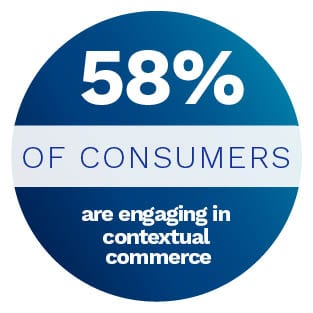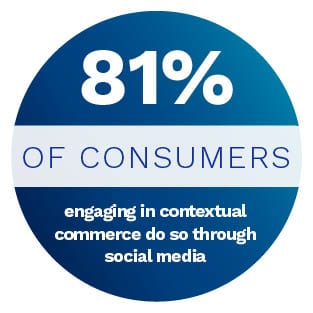Why Contextual Commerce Is Retail’s Future Now

 Shopping is a social experience in more ways than one. Consumers are busy, attached to their smartphones and used to scrolling past thousands of product images per day. They’re using social apps like Instagram to make purchases right from their feed instead of heading to a merchant’s site. They are turning to voice-activated speakers to order groceries as they go about handling their day-to-day chores. In other words, consumers are shopping contextually.
Shopping is a social experience in more ways than one. Consumers are busy, attached to their smartphones and used to scrolling past thousands of product images per day. They’re using social apps like Instagram to make purchases right from their feed instead of heading to a merchant’s site. They are turning to voice-activated speakers to order groceries as they go about handling their day-to-day chores. In other words, consumers are shopping contextually.
 In fact, nearly six out of 10 consumers today shop in the moment — contextually.
In fact, nearly six out of 10 consumers today shop in the moment — contextually.
As contextual commerce grows, merchants need to come up with new strategies to keep up with a consumer base that’s mobile, image-fatigued and easily frustrated with a friction-filled shopping experience.
In the latest edition of the Digital Consumer Report, in collaboration with Samsung Pay, PYMNTS analyzes how contextual commerce is changing how consumers interact and shop with merchants, and how contextual commerce experiences are growing more important for customers who want to shop in their home and through their smartphones. We also examine the role in-home internet of things (IoT) devices are playing in enabling contextual commerce.
AI and Its Role in Contextual Commerce
For consumers who find themselves searching for the products and clothes they see in their favorite TV shows or movies, help may be on the way.
 Artificial intelligence (AI), combined with contextual commerce, is opening new doorways to customers who are consuming more content than ever before, said Tyler Cooper, CEO of contextual commerce company TheTake.AI, in a recent interview with PYMNTS.
Artificial intelligence (AI), combined with contextual commerce, is opening new doorways to customers who are consuming more content than ever before, said Tyler Cooper, CEO of contextual commerce company TheTake.AI, in a recent interview with PYMNTS.
The company is betting on use of AI, neural networks and other learning technologies in development of popular video content to take contextual shopping experiences to the next level.
However, while use of AI can help create contextual experiences, there’s still work to be done for improving consumer engagement.
“We’ve also had to fight the fight of educating our users that the possibility is even there to use this type of service,” Cooper said. “[We’re] educating them that this feature is available, but [we’re] also not making it intrusive, not making it feel like an advertisement.”
For more on this, take a look at the feature story.
About the Report
The Digital Consumer Report, a Samsung Pay collaboration, aims to illuminate the role of AI and machine learning in transforming how consumers and merchants think about customer service in the retail sector. Our analysts dug deep into some of the world’s most innovative companies to learn how real-life merchants use advanced technologies to deepen their customer relationships and optimize their operations.
